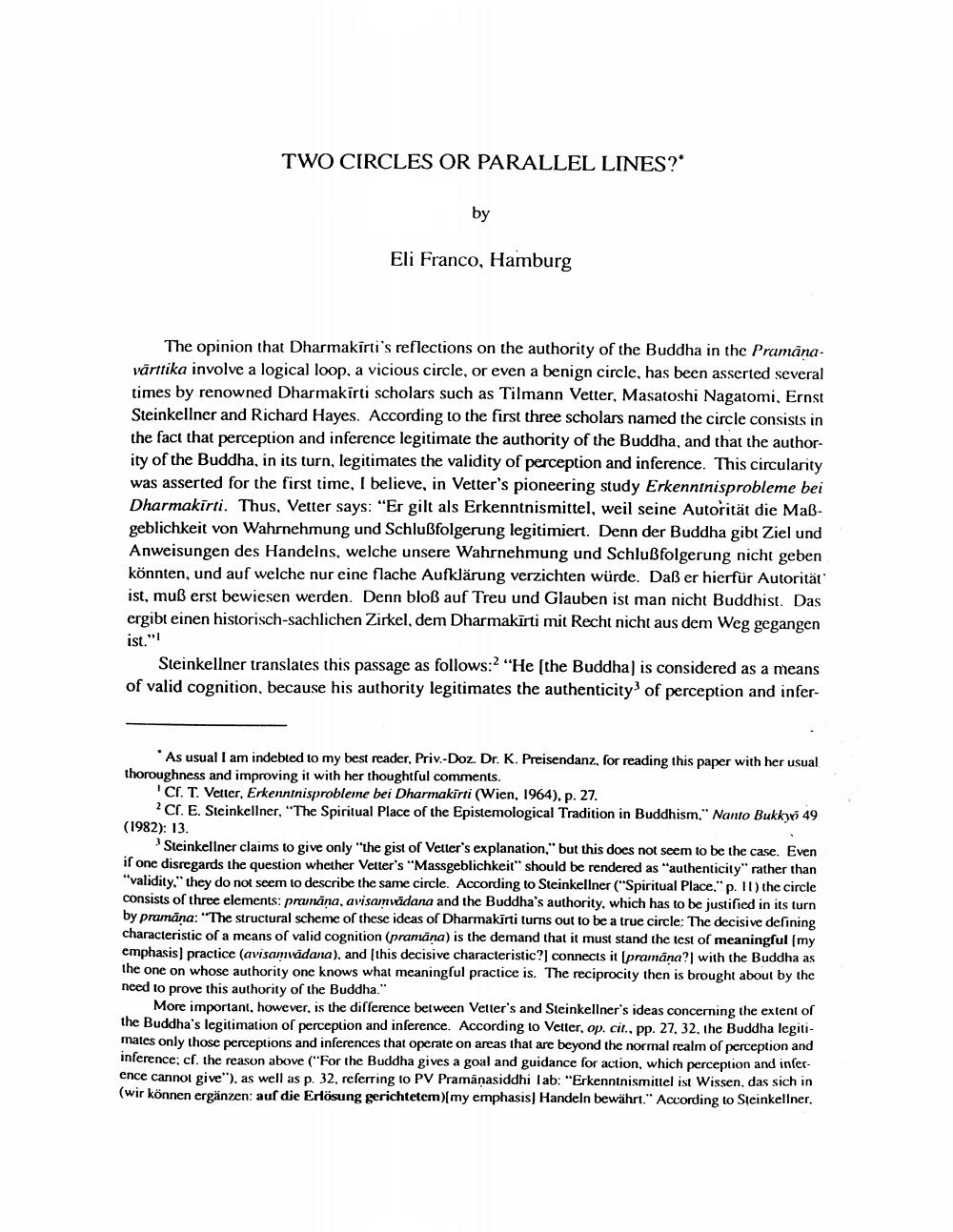Book Title: Two Circles Or Parallel Lines Author(s): Eli Franco Publisher: Eli Franco View full book textPage 1
________________ TWO CIRCLES OR PARALLEL LINES? by Eli Franco, Hamburg The opinion that Dharmakirti's reflections on the authority of the Buddha in the Pramanavärttika involve a logical loop, a vicious circle, or even a benign circle, has been asserted several times by renowned Dharmakirti scholars such as Tilmann Vetter, Masatoshi Nagatomi, Ernst Steinkellner and Richard Hayes. According to the first three scholars named the circle consists in the fact that perception and inference legitimate the authority of the Buddha, and that the authority of the Buddha, in its turn, legitimates the validity of perception and inference. This circularity was asserted for the first time, I believe, in Vetter's pioneering study Erkenntnisprobleme bei Dharmakirti. Thus, Vetter says: "Er gilt als Erkenntnismittel, weil seine Autorität die Maßgeblichkeit von Wahrnehmung und Schlußfolgerung legitimiert. Denn der Buddha gibt Ziel und Anweisungen des Handelns, welche unsere Wahrnehmung und Schlußfolgerung nicht geben könnten, und auf welche nur eine flache Aufklärung verzichten würde. Daß er hierfür Autorität ist, muß erst bewiesen werden. Denn bloß auf Treu und Glauben ist man nicht Buddhist. Das ergibt einen historisch-sachlichen Zirkel, dem Dharmakīrti mit Recht nicht aus dem Weg gegangen ist." Steinkellner translates this passage as follows: "He (the Buddha) is considered as a means of valid cognition, because his authority legitimates the authenticity of perception and infer As usual I am indebted to my best reader, Priv.-Doz. Dr. K. Preisendanz, for reading this paper with her usual thoroughness and improving it with her thoughtful comments. Cf. T. Vetter, Erkenntnisprobleme bei Dharmakirti (Wien, 1964), p. 27. 2 CC. E. Steinkellner, "The Spiritual Place of the Epistemological Tradition in Buddhism." Nanto Bukky 49 (1982): 13. Steinkellner claims to give only the gist of Vetter's explanation, but this does not seem to be the case. Even if one disregards the question whether Vetter's Massgeblichkeit" should be rendered as "authenticity" rather than "validity," they do not seem to describe the same circle. According to Steinkellner ("Spiritual Place," p. 11) the circle consists of three elements: pranana, avisamvadana and the Buddha's authority, which has to be justified in its turn by pramana: "The structural scheme of these ideas of Dharmakirti turns out to be a true circle: The decisive defining characteristic of a means of valid cognition (pramāna) is the demand that it must stand the test of meaningful (my emphasis) practice (avisamvadana), and this decisive characteristic?) connects it (pramana?) with the Buddha as the one on whose authority one knows what meaningful practice is. The reciprocity then is brought about by the need to prove this authority of the Buddha." More important, however, is the difference between Vetter's and Steinkellner's ideas concerning the extent of the Buddha's legitimation of perception and inference. According to Vetter, op. cit., pp. 27, 32, the Buddha legitimates only those perceptions and inferences that operate on areas that are beyond the normal realm of perception and inference; cf. the reason above ("For the Buddha gives a goal and guidance for action, which perception and inference cannot give"), as well as p. 32, referring to PV Pramānasiddhi lab: "Erkenntnismittel ist Wissen, das sich in (wir können ergänzen: auf die Erlösung gerichtetem)(my emphasis) Handeln bewährt." According to Steinkellner.Page Navigation
1 2 3 4 5 6 7 8 9 10
